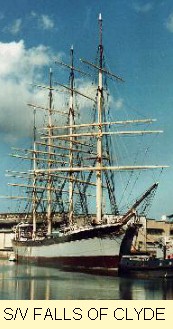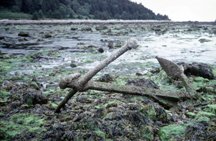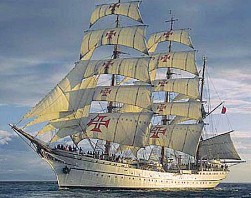Tall Ships
Tall Ships
90 minutes - $24.95
This DVD includes the three programs described below.
Tall Ships
30 minutes - 1965
 Narrated by Clint McCune, this program documents tall ships in the northwest, both above and below the water. Action scenes aloft amidst the rigging and on deck reflect the days when Puget Sound swelled in the wake of these great ships of sail.
Narrated by Clint McCune, this program documents tall ships in the northwest, both above and below the water. Action scenes aloft amidst the rigging and on deck reflect the days when Puget Sound swelled in the wake of these great ships of sail.
Here's an excerpt from the show by writer/narrator Don McCune: “Clouds of canvas falling in ordered folds tighten in the morning breeze, fore and afters sing aloft with a jangle of hanks, and the yellow cordage snakes through a hundred blocks. Here in the Northwest we live in the shadow of that history. Juan de Fuca, Whidbey, Townsend, Vancouver; our land is marked with their names, as are the waters that surround us. And our seas are the final resting place for many whose names we do not know.”
Don and the Exploration Northwest crew travelled to San Francisco to get the footage of the C.A. THAYER, which had just been restored by the San Francisco Maritime Historical Society.
 This black-and-white film includes the ships AUSTRIA (anchor see at left), FALLS OF CLYDE, the sister ships C.A. THAYER and WAWONA, the PETER IREDALE, and the WARHAWK, sister ship to the legendary FLYING CLOUD. This program was re-created by tenderly restoring and digitizing the original 1965 film. The sound track of the original show was lost; this re-creation of the show is narrated by Don's son, Clint McCune. Originally aired under the KOMO title “Wind Ships”.
This black-and-white film includes the ships AUSTRIA (anchor see at left), FALLS OF CLYDE, the sister ships C.A. THAYER and WAWONA, the PETER IREDALE, and the WARHAWK, sister ship to the legendary FLYING CLOUD. This program was re-created by tenderly restoring and digitizing the original 1965 film. The sound track of the original show was lost; this re-creation of the show is narrated by Don's son, Clint McCune. Originally aired under the KOMO title “Wind Ships”.
Tall Ship Voyage
30 minutes - 1979
 The Portuguese NE SAGRES, sistership to the USCG EAGLE, sails from San Francisco to Seattle on a 6-day adventure. Built to train Hitler's navy, the SAGRES was captured by American Forces and purchased by Portugal. The SAGRES provides the setting to tell about the early tall ship explorations of the Pacific Coast and Puget Sound.
The Portuguese NE SAGRES, sistership to the USCG EAGLE, sails from San Francisco to Seattle on a 6-day adventure. Built to train Hitler's navy, the SAGRES was captured by American Forces and purchased by Portugal. The SAGRES provides the setting to tell about the early tall ship explorations of the Pacific Coast and Puget Sound.
Here's an excerpt from the show by writer/narrator Don McCune: "Taking to the shrouds, always on the weather side so the wind blows them into the rigging not off, the race is on to loose the sails. And swarming aloft, pounding feet shake the rigging as eager hands leap for the yards. Laying out over the yard and balanced on the flailing foot-rope, 30 men take to the mast. Cape Horners considered this safer than working on a wave-washed deck, but to a young cadet fighting rain-sodden canvas 150 feet in the air, it's both a purgatory and a proving ground." Originally aired under the KOMO title “NE SAGRES.
Shipwreck Trail
30 minutes - 1977
Once used to save shipwreck victims, the old "Life-saving Trail", along Vancouver Island's rugged west coast, between Port Renfrew and Barkley Sound, is still a tough hike. The recreational trail no longer serves to save lives but to expand the spirits of those who use it. Now part of the Pacific Rim National Park, there also is beauty of crashing surf, the rocky coast and sandy beach. Once known as "The Lifesaving Trail," this 40-mile hike contains 40 shipwrecks. Above the booming surf, one can find graves of half-buried wreckage.
Here's an excerpt from the program by writer/narrator Don McCune: "Who discovered the Strait of Juan de Fuca has long been a matter of controversy. Named after the Spanish explorer, who was actually a Greek in service to Spain, the Strait was named by Captain William Barkley who was off the entrance in July of 1787 and recognized it from an accurate description of its geographical features at its approach given by the Greek. On the north side of the Strait, Vancouver Island's West Coast proved to be altogether inhospitable. Early mariners often found themselves blown onto the its shore by pounding seas. Those who survived still faced an almost impenetrable rain forest, whose remoteness also contributed to the loss of lives. Eventually, a life-saving trail was built along this infamous section of coastline. This week we'll hike the recreational trail which no longer serves to save lives, but to expand the spirit of those who hike this part of the Pacific Rim National Park."
Originally aired under the KOMO title “West Coast Trail”.